| ||||||||||||||||||
| ||||||||||||||||||

News Flash: I'm in print! See the October 2001 issue of Sky and Telescope magazine, on pages 6, 128, 129 and 132. They published the image that is second from the left in the banner above.
|
What is a total solar eclipse? Well, through an amazing coincidence in geometry, every few years the Moon blocks out the Sun creating a solar eclipse. The Sun is 400 times the size of the Moon, and 400 times as distant, so they appear to be the same size when viewed from Earth. When the orbit of the Moon takes it between the Sun and the Earth, the shadow of the Moon is cast upon the Earth. If the Moon is close enough to the Earth, someone located near the middle of that shadow will see the Moon exactly block out the Sun in a spectacular show. This is a "Total Solar Eclipse", arguably the most spectacular show in astronomy.
Total Solar Eclipses (TSEs) happen every few years, in strips laid across seemingly random parts of the globe. (Click here for a map of TSEs during 1996-2020, courtesy Fred Espenak of NASA). This time southern Africa was the place to be on June 21, 2001. The map at right shows the maximum eclipse experienced at locations across all of Africa, and is a mosaic made from my actual images of the eclipse. I wasn't comfortable with arranging the trip by myself as I was not familiar with the countries or what to expect. I therefore booked myself and my sister Monica on a tour offered by Astronomical Tours, a travel agency designed for amateur astronomers like me. Many tours book full up to a year in advance, and so I was lucky to get in on a cancellation. As part of this tour we travelled to Landless Corner, Zambia to view the eclipse. More info about the tour and what we saw (besides the eclipse) is available in the full trip report. All photos on this page and the trip report pages were taken by me (Fred) or by Monica (my sister). |
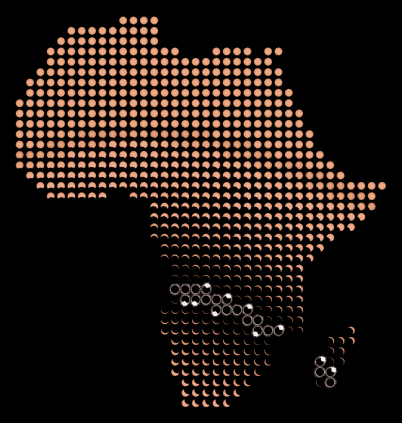
|
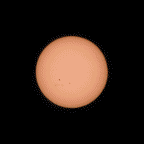 |
Our day began in Livingstone, Zambia at the first-class Zambezi Sun hotel, adjacent to Victoria Falls. We flew to Landless Corner on the Victoria, a sixty-year-old DC3, and landed on the grass strip prepared by the Landless family. We picked out our observing site, near some shade trees, and began setting up. I was fully set up in 10 minutes, but other folks took 1-2 hours to get going. Preparation and simplicity pays off big time in a place like this. Other members of the group had suffered problems like a broken ETX telescope mirror, a broken tracking motor, and so on. I had no equipment damage on the trip until the last day, when a small bug crawled between the glass elements of the lens in my digital camera. Don't ask me how it did it!
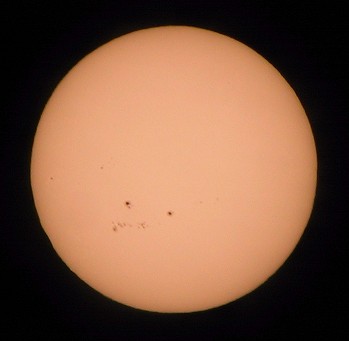
| Hint: at eight o'clock there is a dent in the Sun. |
As the eclipse progressed more and more of the Sun was covered. Members of the group had great fun letting people look through their telescopes at the Sun. We were especially keen to let the locals look, as they were very superstitious about the event by all accounts. There were some nice sunspots that added interest as the Moon crawled across the Sun. Below is a closeup. You may notice that the silhouette of the Moon is somewhat ragged and rough; these are the actual mountains and valleys on the Moon. The dark central spots of the two largest sunspots are each about the size of the Earth.
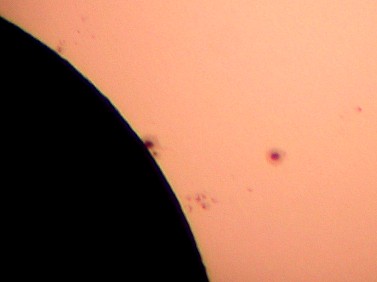
We all went on a hunt to find the best object to project crescents with and onto. The winning combination was a coarsely woven hat and the back of my white shirt, on which you could see hundreds of tiny sun crescents. Closer to second contact, we saw some birds flying by and acting like it was evening, though it was about 2:30-3pm. Second contact is the biggie, when totality and the real show starts because the Moon has covered the Sun completely.
When the Moon covered all but a tiny sliver of the Sun, the Diamond Ring effect appeared. We removed our filters and had some gorgeous views of it.
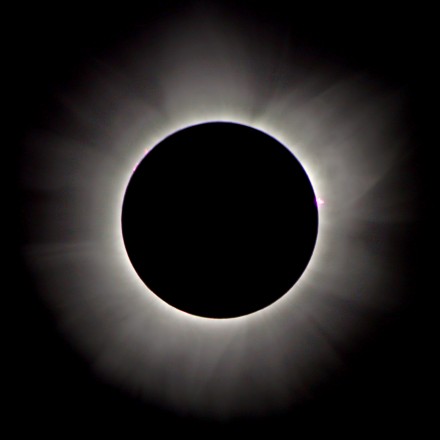 |
The sight of the corona (whitish wispy streamers) and large prominence (reddish "flames") was simply amazing. The corona was fairly short, with most of the light bunched up close the the Sun and no long streamers. I could see the planet Jupiter nearby, and the star Sirius above. I think there were other stars/planets visible, but I didn't take the time to figure out what was what and remember them. The sky was not completely black, but rather a dark blue-gray, changing to golden red all around the horizon. Below are some closeups of the prominences that were visible.
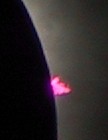 |
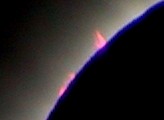 |
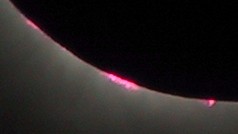 |
Our plane and flight crew, back from refueling in Lusaka, didn't make it onto the ground in time and witnessed totality from the air. The sight of the magnificent DC3 arcing just in front of us and under the fully eclipsed Sun was a beautiful sight, I wish I could have captured that. The copilot later told us of how he was caught off guard by the extreme darkness and was scrambling to turn on lights. They were able to bank the plane and see the eclipse pretty well. I'm sure that flying a historic aircraft while watching the eclipse was a highlight of their careers.
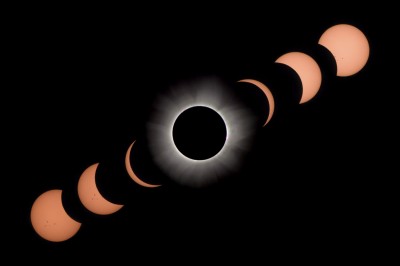
We could see the western horizon brighten, signalling the approaching end of totality. Totality lasted 3 minutes and 34 seconds at our location. I simply could not believe how fast those minutes went by. It felt like five seconds. My carefully laid plans for photography went completely out the window because there simply was no time! For other photographers out there: practice, practice, practice, until you can do your routine without thinking. Your mind will be on the amazing things you are seeing. Also, learn everything by feel; it's dark!
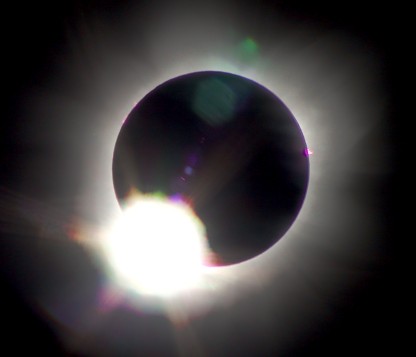
|
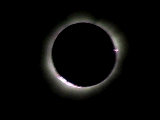
|
Totality was followed by another Diamond Ring at third contact. Third contact is when the Moon no longer completely covers the Sun, and is the end of totality. This signals the end of the big show. The cheering and shouting from the distance rose up again and continued for a while. If your computer is fast enough, the animated version of third contact above is shown in real time; that's exactly the speed it happened. Monica sketched this wonderful drawing of the eclipse at this point:
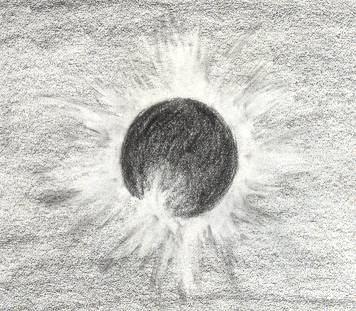
After totality we talked and shared impressions. Some folks got drunk. My sister was somewhat ambivalent towards the event, as she is not astronomically minded. A long steady line of cars and trucks that lasted half an hour came up on the Great North Road (northbound, presumably they were closer to the centerline) honking their horns and shouting. Some of the planes at our airstrip took off soon after totality ended, kicking up a lot of dust. It was probably less than ten minutes after totality when the next TSE (December 2002) was mentioned, and we had a good discussion on whether to go to Africa or Australia for it. Africa will be in the wet season, Australia has only 30 seconds of totality. It's a "lesser of the two evils" type of decision.
The eclipse didn't end with third contact, the Moon still had to move off from the Sun. One member of our group commented that the partial phases after totality are probably the least observed astronomical phenomenon there is, and I believe him. I was probably the only person who kept shooting all the way to fourth contact, when the Moon moves off the Sun completely and everything returns to normal.
Our group stayed around until fourth contact, and then packed up and flew back to Livingstone, tired but satisfied. Thanks to digital technology, several of us shared our pictures of the eclipse on the way back. If we had coordinated more and brought the right cables, we could have swapped pictures, transferring them between cameras.
Don't forget to check out the full trip report at some point.
Below is a panorama I created with my digital camera. You can click on it to get a 360 degree Quicktime 4.0 VR panorama (739k) of the whole area.

As for the equipment I took to photograph the eclipse, I had a Sony DCR-TRV120 Digital8 video camera with 25x optical zoom on a tripod, and a telescope with digital camera (links point to my supplier). The telescope was an Orion ShortTube 80mm F/5 refractor, modified to place a 1/4-20 socket further back, closer to the center of gravity when the digital camera was attached. I used an Orion solar filter for the telescope, and Baader AstroSolar film on the video camera. Attached to the telescope was then a spacer (actually an empty eyepiece projection adapter) and eyepiece projection adapter, with a 2x Apo Barlow and cheapo 25mm eyepiece inside. This connected to a T-to-49mm adapter, to a Lensmate adapter, to my Canon Powershot G1 digital camera. The G1 had an IBM 1GB Microdrive inside to make sure I would have space for all the pictures I wanted to take. I did actually run out of space on the Microdrive before the end of the trip and had to delete pictures. I had purchased a bunch of spare batteries also. FedEx and UPS love me.
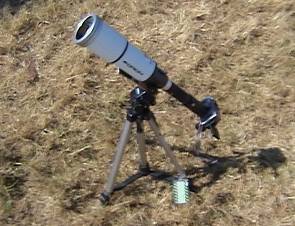
The telescope and digital camera combination took many weeks to figure out. I wanted to be able to zoom out to get the corona, and zoom in to see sunspots and prominences. The difficult thing was getting the camera lens close enough to the eyepiece, and finding an eyepiece with glass right at the top with no eyecup. I used the IR remote to fire the camera instead of a cable release, and took advantage of the camera's AEB (Automatic Exposure Bracketing) feature extensively during totality. All images on this page were taken at 50 ASA unless otherwise noted.
Over the entire trip Monica and I took about 1,200 digital photos, 125 film photos, and 3.5 hours of video. 225 photos were of the eclipse itself (through the telescope).
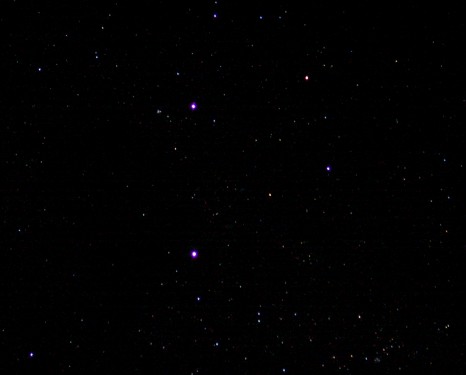
I spotted the Moon the day after the eclipse, when it was about 27 hours old, just after sunset in Chobe while we were on a game drive. The next day I took this photo of the two-day-old Moon with my telescope and digital camera:
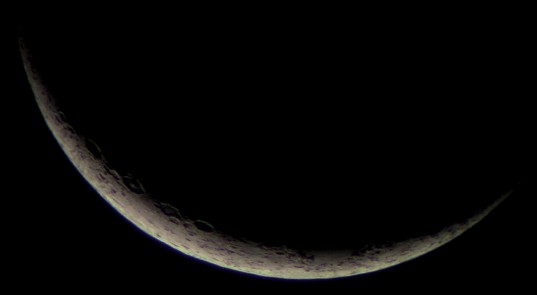
Solar eclipses I have seen:
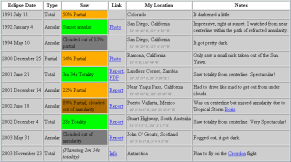
|
Please click here for photos and reports of other solar eclipses I have observed, attempted to observe, or plan to observe.
|
Full Trip ReportWe also have a report about the other destinations and events on our trip. Please select as appropriate:
Epilogue: The 59-year-old DC-3 airplane (Victoria) we flew in crashed in the Congo six months after our trip. |
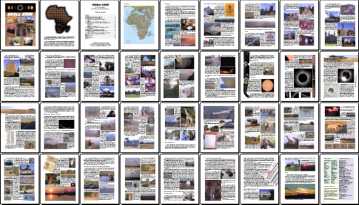
|
Please visit my main astronomy page, or check out my homepage.
Comments? Questions? Click here to send email to me, Fred Bruenjes.
All text and images are © 2001 Manfred Bruenjes - All Rights Reserved. Image inlining is strictly prohibited. Email for permission before using an image or text.